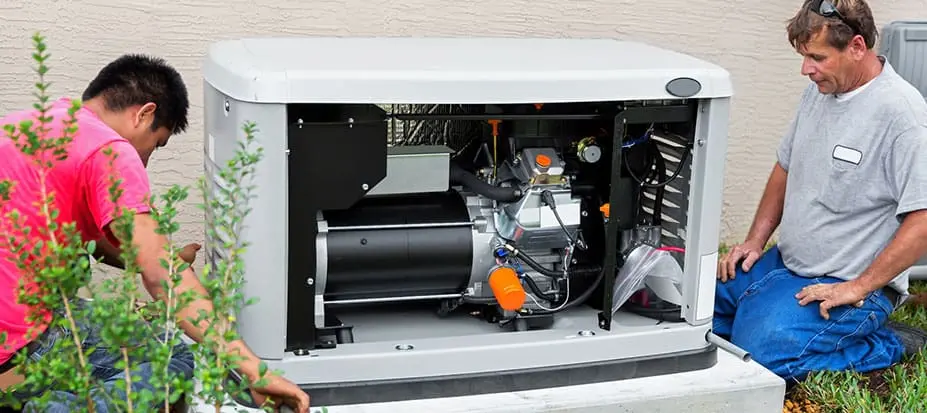
Installing a generator in your home can be a lifesaver during power outages. Whether you’re looking to power a few key appliances or your entire home, following a few simple tips can ensure a smooth installation process. In this guide, we’ll walk you through the steps to make your generator setup easy and trouble-free.
1. Understanding Your Power Needs
Before purchasing a generator, it’s crucial to determine your power requirements. Consider what appliances and systems you want to keep running during an outage and calculate the total wattage needed. To establish a precise power blueprint, start by listing all critical appliances like refrigerators, sump pumps, and heating systems. It’s essential to prioritize which items are non-negotiable during an outage. This methodical approach will help you avoid purchasing an undersized or oversized generator. Utilize online wattage calculators to gain a clearer understanding of your exact power needs; this aids in making informed decisions without overspending.
Once you’ve outlined your power needs, consider how a generator fits into your lifestyle and budget. Do you want a unit strong enough to power the entire home or just keep essential electronics running? It’s key to find balance so you invest wisely while ensuring your home operations stay smooth in emergencies. Consult with experts who can analyze your detailed needs and recommend suitable models, ensuring you invest in a generator tailored to your specific requirements.
2. Choosing the Right Generator
Generators come in various types and sizes, including portable, inverter, and standby models. Select one that aligns with your power needs and budget. Standby generators, while more expensive, offer the convenience of a seamless power transition when an outage occurs. They are permanently installed on your property and connect directly to your home’s power supply, making them a hassle-free option during emergencies. For many, the peace of mind they offer is worth the cost. Portable generators, on the other hand, are more affordable and flexible, allowing for use in multiple locations.
If you’re considering a standby generator, it’s also worth noting how these units connect to your utility’s natural gas supply. This ensures a constant fuel source and minimizes manual intervention. Additionally, automatic generators provide greater safety and convenience since they turn on automatically during an outage and switch off when power is restored. For those residing in areas prone to frequent storms or blackouts, investing in an automatic standby generator may be the optimal choice.
3. Selecting the Perfect Location
Find a safe, well-ventilated spot for your generator. It should be away from windows and doors to prevent carbon monoxide fumes from entering your home. Proper ventilation is critical to prevent dangerous gas buildup that can lead to silent but deadly consequences. Moreover, placement away from living areas will minimize noise disturbances when the generator is in operation. According to maintenance experts, choosing a spot with clear access for maintenance checks is pivotal to ensure long-term functionality without disruptions.
Generators perform best in protected locations, away from elements like rain or snow, which can cause electrical hazards. Installing a canopy or housing structure can provide necessary protection while maintaining adequate airflow. Keep in mind that most zoning regulations dictate how close a generator can be placed in proximity to your property line, so it’s crucial to verify local codes as you finalize your selection.
4. Checking Local Building Codes
Consult local regulations and obtain the necessary permits before starting the installation process. Compliance is essential for safety and reliability. Each municipality will have its own set of rules and standards regarding generator placement, noise restrictions, and overall installation process. By adhering to these guidelines, you ensure that your installation is both legal and safe. Take advantage of local installation services that often offer consultations to guide you through the permit acquisition stage.
Familiarize yourself with the paperwork involved in acquiring permits as this process can be time-consuming. It’s also wise to communicate with your neighbors about the installation to alleviate concerns about noise or disruption, ensuring community harmony. While this step may seem tedious, compliance with local codes ensures the safety of your home and family while preventing any future legal hassles.
5. Hiring a Professional Installer
For a seamless installation, consider hiring a licensed electrician. They can ensure the proper connection and functioning of your generator. Professional installers bring expertise that guarantees all electrical connections meet local safety standards and that the generator integrates smoothly with your home’s systems. This reduces the risk of faults or damage that can arise from DIY attempts.
Moreover, certified installation experts can assist in troubleshooting issues you may face post-installation. From navigating complex wiring to securing the best spot for noise control, a professional’s input can save time and future repair costs. Choose qualified professionals who have good reviews and experience dealing with the specific model you’ve purchased.
When you choose a certified installer, they often provide maintenance tips that prolong the life of your generator. They can walk you through basic operations and set up a maintenance schedule. As installation is a significant investment, having expert-backed assurance of a job well done goes a long way in protecting that investment.
6. Preparing a Transfer Switch
A transfer switch is crucial for safely switching between utility power and generator power. Have it professionally installed to avoid any electrical hazards. Transfer switches prevent back-feeding, which occurs when power flows back into the main transmission lines, posing a risk to utility workers working on the lines during an outage. Back-feeding can cause serious injuries and damage if not correctly addressed.
Transfer switches function as the changeover point between utility and generator power. Whether opting for a manual or automatic setup, having this switch installed according to your power setup is non-negotiable for safe operations. Opting for models that offer seamless transition can particularly be advantageous for avoiding disruptions during unexpected blackouts.
7. Understanding Maintenance Requirements
Regular maintenance, such as oil changes and filter replacements, keeps your generator in top condition. Follow the manufacturer’s guidelines for upkeep. Routine checks not only extend the generator’s life but also improve its efficiency and reliability. Some models offer built-in diagnostics to alert you when maintenance is required, providing comfort and continuous dependability.
Further, consider investing in service plans that offer routine inspections and thorough checks by experts. Many companies offer packages that include annual inspections and emergency repairs, ensuring your generator is always ready. Understanding the specifics of your generator’s maintenance schedule with brands such as Generac or Briggs & Stratton will help you keep everything in optimal condition.
8. Stocking Up on Fuel
If you’re using a gasoline or diesel generator, ensure you have an adequate fuel supply. Store it safely and be aware of expiration dates. Fuel stability is vital to efficient operation. Using old, stale fuel can lead to operational issues or damage to your generator. Rotate your fuel stock to ensure you’re using it within a safe timeframe, especially if outages are infrequent in your area.
For those with standby generators, connecting to a natural gas supply eliminates the need for fuel storage, offering peace of mind as the gas is continuously supplied. If concerned about fuel interruptions, such as during major natural events, consider a dedicated LP tank backup. Regardless of the fuel type, remember to check that all connections are secure, and tanks are free from leaks to prevent hazards.
9. Testing Your Generator
Conduct regular tests to familiarize yourself with operating the generator. This will help you act swiftly during an actual power outage. Monthly test runs enable you to identify any potential issues and address them promptly. Regular testing is essential not only for checking the functionality but also for keeping the battery charged and systems lubricated.
Test running also ensures that you are comfortable with starting, stopping, and operating your generator. Understanding the process during non-emergency conditions reduces stress when a power outage occurs. Consider setting reminders or enrolling in a monitoring plan that notifies you about routine test requirements, ensuring you never miss a crucial check.
10. Creating an Emergency Plan
Involve your family in planning for emergencies and power outages. Ensure everyone knows how to operate the generator and follow safety protocols. Simulating power outages and practicing the appropriate response makes sure everyone is prepared and confident in the procedure if an actual event occurs. Having a designated team leader during outages can streamline communication and decision-making.
Further, create an inventory of all necessary emergency supplies alongside your generator instructions, so they are easily accessible. This includes battery-operated flashlights, radios, bottled water, and non-perishable food items. Informing your family about the location of safety equipment and how to safely operate the generator during an outage rounds out a comprehensive emergency plan.
11. Conclusion: Power Up with Confidence
The right generator can transform the way you weather a storm or an unexpected power outage. Following these steps ensures that your installation is streamlined, safe, and suits your specific needs. Dive deeper into the benefits of standby generators with Stashluk, where we share insights on choosing the perfect model. At Stashluk, we offer more than just guidance — our experts provide reliable support and maintenance to keep your generator ready for any eventuality. For peace of mind and quality assurance, explore our home generator solutions today!



